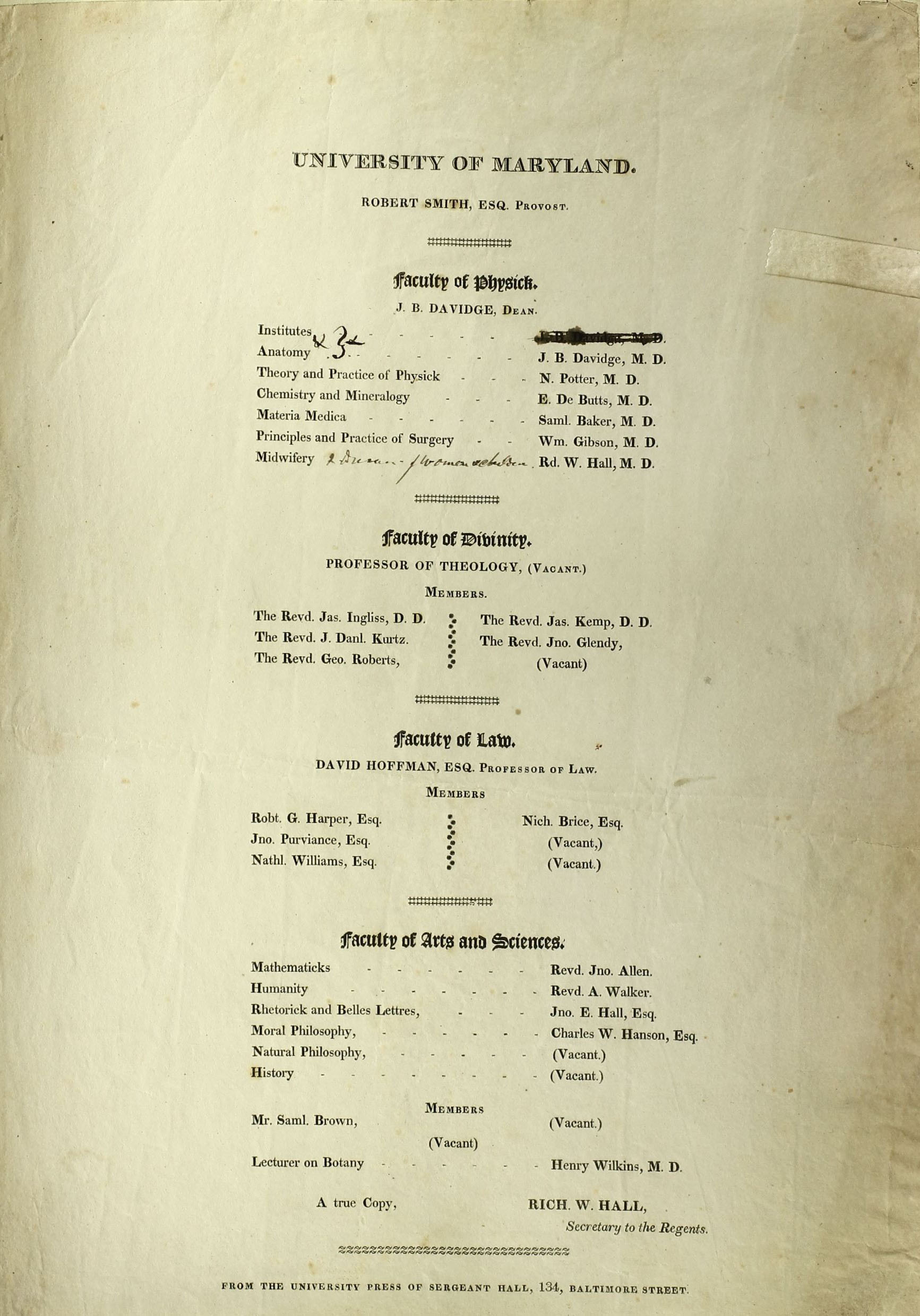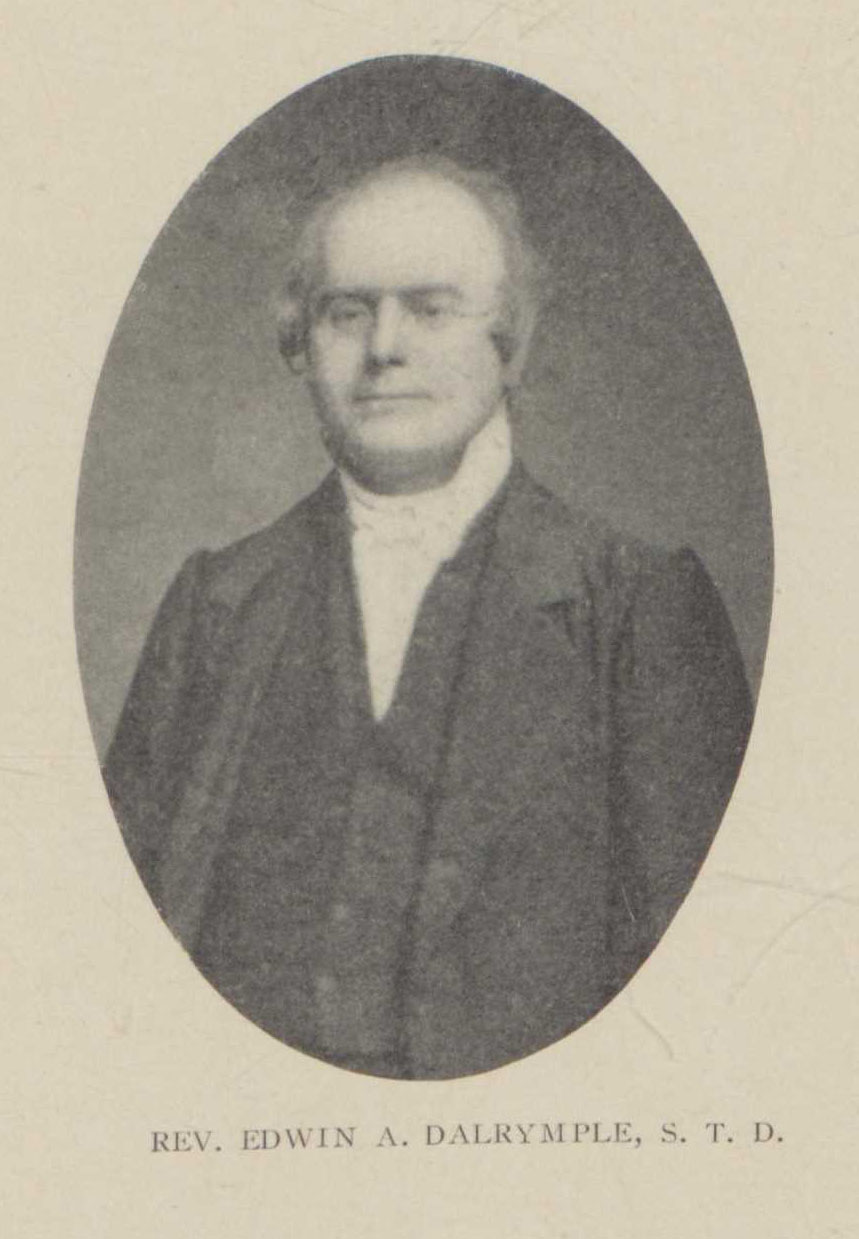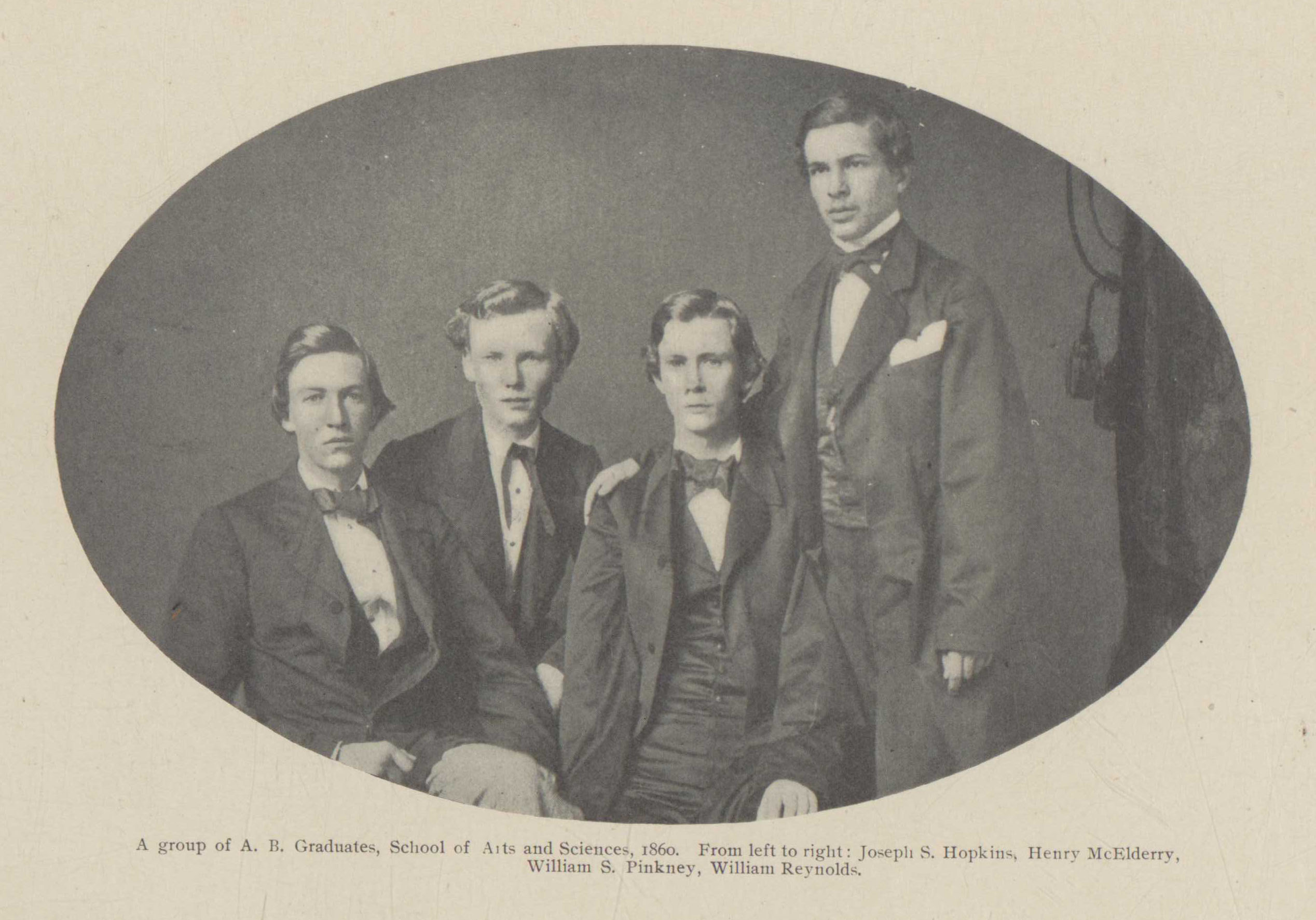The Health Sciences and Human Services Library Historical Collections’ strives to provide broad access to our diverse collections both in person and digitally. Materials in our collections appear as they originally were published or created and may contain offensive or inappropriate language or images and may be offensive to users. The University of Maryland, Baltimore does not endorse the views expressed in these materials. Materials should be viewed in the context in which they were created.
Throughout its long history, the University of Maryland, Baltimore (UMB) has seen many other Baltimore colleges and universities open and close. Some of these schools simply shuttered their doors, while others merged with UMB. Historical Collections still houses materials from some of these schools. This year, Historical Collections aims to tell the stories of these defunct schools in blog posts.
To begin, Historical Collections is highlighting UMB’s own School of Arts and Sciences. When the College of Medicine of Maryland (founded in 1807) became the University of Maryland in 1812, the law (MD Session 1812, Chapter 159) also established three additional schools—Divinity, Law, and Arts and Sciences—in addition to the existing School of Medicine. Faculty meeting minutes dated November 1812, include the lists of Faculty for these schools.
According to these minutes, the first Faculty of Arts & Sciences were:
Charles Hanson Esq., Professor Moral Philosophy.
Reverend John Allen, Professor Mathematics
Reverend George Ralph, Professor Rhetoric & Belles Lettres
Reverend Archibald Walker, Professor of Humanity
John D. Craig Esq., Professor of Natural Philosophy
John E. Hall Professor of History
Samuel Brown Esq., Member of Faculty
 While a faculty was established in 1812, the School of Arts & Sciences did not flourish until the 1850s. The school was not dormant during this time as money was allocated for the purchase of a building, furniture, and teaching apparatus. The Maryland Legislature on February 7, 1830 passed a law (Chapter 50) uniting a failing Baltimore College with the University of Maryland School of Arts and Sciences.
While a faculty was established in 1812, the School of Arts & Sciences did not flourish until the 1850s. The school was not dormant during this time as money was allocated for the purchase of a building, furniture, and teaching apparatus. The Maryland Legislature on February 7, 1830 passed a law (Chapter 50) uniting a failing Baltimore College with the University of Maryland School of Arts and Sciences.
Baltimore College was established on January 7, 1804, by Maryland legislature (Chapter 74) under its first Principal and Founder James Priestley; it was the first non-secular college in Baltimore. In 1811, Baltimore College erected a building at 32 Mulberry Street. Unfortunately, the school never really flourished and no degrees were ever granted. When the College was transferred to the University of Maryland the building became the property of the University; thus, the School of Arts and Sciences had a home. The Baltimore College named, continued to be used in conjunction with the University of Maryland School of Arts and Sciences into the 1850s.
In January 1831, the “Collegiate Department” of the School of Arts and Sciences officially opened with eleven professors teaching Ancient Languages, History, Political Economy, Natural Philosophy, Mineralogy and Geology, Natural History, Rhetoric and Belles Lettres, Moral and Intellectual Philosophy, Botany, Mathematics, and Chemistry applied to the Arts. The general public was permitted to attend courses for free—without earning a degree—with the hope that they would then enter the college as paying students. The cost for students looking to earn a degree was set at $100 per year.
Unfortunately, the school continued to struggle as it had few students and no endowment, and by 1842 the school appeared to be on the verge of closing. On March 3, 1843, the Baltimore Commissioner of Public Schools petitioned to have the UM Regents transfer the building to the city for the use of high schools. This petition was found to be illegal and the Mulberry Street building remained under the ownership of the University. By April 1852, there were only 36 students enrolled and only one professor, Mr. Horace Morrison, A.M. continued to lecture.
 In October 1854, Mr. Morrison, was forced to resign as principal and Reverend E.A. Dalrymple took over the leadership of the school. Dalrymple was born in Baltimore, educated at St. Mary’s College and the Theological Seminary in Alexandria Virginia. In 1845 he became principal of the Episcopal High School at Alexandria and was known to be a tough teacher who believed schools should teach students how to learn not just facts and figures.
In October 1854, Mr. Morrison, was forced to resign as principal and Reverend E.A. Dalrymple took over the leadership of the school. Dalrymple was born in Baltimore, educated at St. Mary’s College and the Theological Seminary in Alexandria Virginia. In 1845 he became principal of the Episcopal High School at Alexandria and was known to be a tough teacher who believed schools should teach students how to learn not just facts and figures.
When Dalrymple took over, the name of the school was changed to “The School of Letters of the University of Maryland.” There were two divisions: Preparatory and Collegiate. The Preparatory Department was meant for students looking to attend college but needing foundational education or those looking to enter business or commercial industries. The Collegiate Department was meant for students ready for education at a bachelors’ degree (A.B.) level. Three class levels were established in the Collegiate Department: Junior, Middle, and Senior. The Freshman year was completed in the Preparatory Department. Two degrees were offered: the A.B. (Bachelor of Arts) and the A.M. (Master of Arts). The 1854-1855 session—the first under Dalrymple—began with 23 students enrolled. By the following year there were three times as many students (74) enrolled.
Enrollment peaked in the 1857-1858 academic year, with 121 students enrolled. In 1859, the first student, Isaac Brooks Jr., graduated from the University of Maryland School of Letters. The following year, four students received the A.B. Degree: William S. Pinkney, William Reynolds Jr., Henry McElderry, and Joseph S. Hopkins. William S. Pinkney and William Reynolds Jr. returned to their Alma Mater as faculty following graduation. Reynolds served as a mathematics instructor in 1862 and Pinkney as professor in Latin, Greek, and Mathematics. The class of 1860 was the largest graduating class of the School of Letters.
List of Graduates:
1859: Isaac Brooks Jr.
1860: William Reynolds, Henry McElderry, Joseph S. Hopkins, William S. Pinkney
1861: Theodore C. Gambrall, Alexander M. Fulford, George W. Abell
1863: David S. Denison
No additional students received A.B. Degrees following the 1863 commencement in part because of the American Civil War; however, the Preparatory Department continued to enroll students. During the Civil War, people had little money or bandwidth for education and the University of Maryland felt that struggle. By 1872, only Rev. E.A. Dalrymple remained as a faculty member, while he attempted to fill the vacant School of Letters positions, the University leadership would not sanction his appointments. In 1878, the Mulberry Street building was completely vacated by the School of Letters and turned over to the UM School of Law. The School of Letters became defunct.
However, in 1903, the University of Maryland, feeling pressure to revive the Department of Arts and Sciences, began to discuss reopening the school. A January 1905 article in the Old Maryland newsletter, suggests that the University was under criticism because it did not have an Academic Department, a President or Provost, a Board of Trustees, or an Endowment. The criticism went so far as to suggest that the school was not a “true University.” That same year, the first communication occurred between Dr. Thomas Fell, President of St. John’s College, and the University of Maryland leaders about the college serving as the Department of Arts and Sciences for the University.
St. John’s College, located in Annapolis, was chartered in 1696 as King William’s School. It received its Collegiate Charter in 1784 and offered B.A., B.S., and M.A. degrees. The course of instruction included biology, international and constitutional law, mechanical engineering, military science with some graduates becoming officers of the US Army. In November and December 1906, meetings occurred with the Governor of Maryland, Edwin Warfield, and high standing members of the University of Maryland to consider the union. The result was the formation of a Council to outline the regulations for the course of study and degrees. The Council created curriculum and looked at ways to shorten the amount of time needed to graduate from St. John’s and attain professional degrees at the University of Maryland.
In 1907, St. John’s College was officially named the Department of Arts and Sciences of the University of Maryland. From the years 1910 to 1920, the Department of Arts and Sciences graduated 230 students. In 1920, the University of Maryland (Baltimore) merged with the Maryland College of Agriculture (University of Maryland College Park) and the relationship between St. Johns College and the University of Maryland ended. The merger meant that the University of Maryland College Park took over the role of educating students in the arts and sciences and the Baltimore campus served as a professional school.
References and Additional Reading:
Cordell, Eugene F. (1907) University of Maryland, 1807-1907, its history, influence, equipment and characteristics… Available at: http://hdl.handle.net/10713/12583
Pinkney, W.S. (1865) University of Maryland School of Letters Volume. Available at: http://hdl.handle.net/10713/22592
Reynolds, William R. (April 1907) “Reminiscences of the School of Arts and Sciences of the University.” Old Maryland. Available at: https://archive.org/details/oldmaryland0304unse/page/n57/mode/2up
“Shall we have an Academic Department” (January 1905) Old Maryland. Available at: https://archive.org/details/oldmaryland0102unse/page/n13/mode/2up
Winslow, Randolph. (June 15, 1906) “The University of Maryland in 1871 and in 1906.” The Hospital Bulletin. Available at: https://archive.org/details/hospitalbulletin02unse/page/n55/mode/2up

